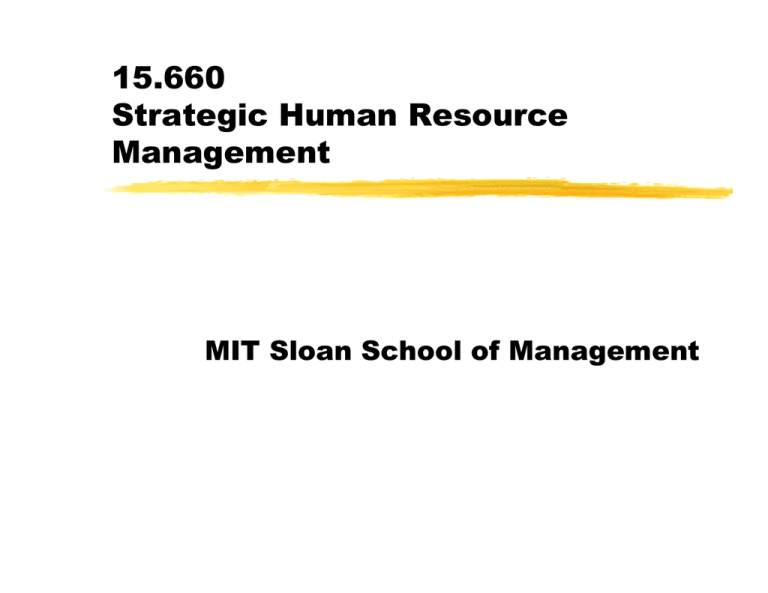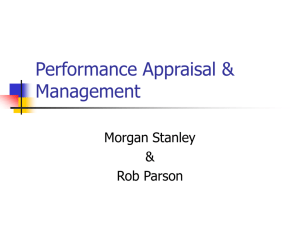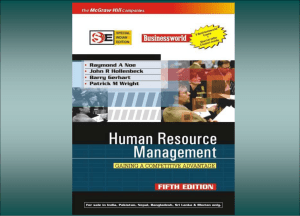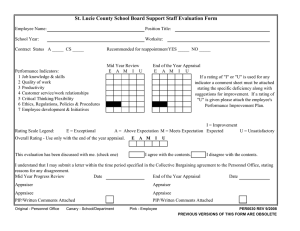15.660 Strategic Human Resource Management MIT Sloan School of Management
advertisement

15.660 Strategic Human Resource Management MIT Sloan School of Management Objectives • Apply and integrate the course material in an analysis and discussion of the Morgan Stanley case today. • Consider what and how John Mack should proceed in implementing his new strategy and vision for Morgan… with special attention to the alignment and consistency of HR levers. Questions ? ? ? Why does Mack want a “one-firm firm”? What would a “one-firm firm” look like? What is different? Morgan Stanley Mission Statement Our goal is to be the world’s best investment bank and the firm of choice for our clients, our people, and our shareholders. We will succeed by meeting the global needs of our clients -- both providers and users of capital -- at a level of performance which is exceptional. This commitment to add maximum value will be characterized by extraordinary effort and innovation, and by conducting ourselves with absolute integrity. Morgan Stanley’s people are the source of our competitive advantage. We will distinguish ourselves by creating an environment that fosters teamwork and innovation, by developing and utilizing our employees’ abilities to the fullest, and by treating each other with respect and dignity. Goals for the new performance system ? ? ? ? ? ? ? ? ? Enhance the professional development of all employees. Achieve greater objectivity and fairness, and base performance evaluation on explicit performance criteria that broadly define desired behavior. Increase real-time feedback. Recognize superior, long-term professional performance. Provide the primary basis for annual compensation and promotion decisions. Provide more substantive annual performance appraisals. Encourage teamwork. Increase cross-departmental and cross-divisional feedback. Increase the consistency and confidentiality of the process. Mini-lecture Performance Appraisal Systems Deming on Performance Ratings Performance evaluations leave “people bitter, despondent, dejected, some even depressed, all unfit for work for weeks after rating, unable to comprehend why they are inferior. It is unfair, as it ascribes to the people in a group differences that may be caused totally by the system that they work in... People ask how I grade my students. I give them all an ‘A.’ How do I know who will be great? How do I know what they will do in future years?” Do Do you you agree agree with with him? him? Purposes of Performance Appraisal ? ? ? Communicate strategy, values, expectations. Build the culture Evaluation ? ? ? ? Development and Feedback Legal defense ? ? ? Current job (e.g., salary and bonus) Future jobs (e.g., promotion) Hiring and promotion decisions Validation Equity and fairness Problems in Performance Rating ? ? ? ? ? ? ? ? ? Halo Stereotypes Overweight negative information Lack of sufficient observation Memory: primacy / recency Leniency Central tendency Justification for salary Ability to write Performance Management System Trait Ratings Global rating Forced Ranking MBO BARS / BES 360 Degree Pros Cons Evaluating Rating Formats Rating Formats Trait Rating Forced BARS Ranking MBO 360 Degree 1. Acceptability, poor feedback poor good good very good 2. Appropriate for Rewards fair good good good good 3. Accuracy, Validity poor fair good good very good 360 degree feedback Peers Peers External External Customers Customers Internal Internal Customers Customers Focal Focal Person Person SelfSelfAppraisal Appraisal Boss Boss Subordinates Subordinates Companies Using 360º Systems ? ? ? ? ? ? ? ? ? ? ? Alcoa American Airlines AT&T American Express Boeing General Electric Glaxo General Mills Hewlett-Packard Intel Monsanto ? ? ? ? ? ? ? ? ? ? ? Merck Herman Miller J.P. Morgan Morgan Stanley Motorola Procter & Gamble Levi Strauss 3M UPS FedEx Compaq Benefits of 360 degree appraisal ? ? ? ? ? ? ? ? ? Validity and accuracy Better acceptance by people rated Promotes equity Legal protection Diversity Useful when spans of control are large Better for knowledge workers More appropriate for team-based system Appropriate for empowered cultures Common Pitfalls ? ? ? ? ? ? ? ? ? ? Lack of safeguards Over-reliance on technology Administrative overhead Incongruence with the culture Incongruence with other systems Cronyism in selection of raters Lack of training Lack of supervision and follow up Results in too much data Not linked to key success factors Some Issues to Resolve ? ? ? ? ? What’s the purpose (feedback, rewards)? How are the raters selected? Who sees the results? How is rater anonymity protected? What dimensions are evaluated? Guidelines for Effective Performance Appraisal ? ? ? ? Make sure the performance rating process is strategically useful; i.e., based on the key success factors needed for execution. Involve those being rated in the development of the rating scheme. Insure that the process is related to job performance and meets legal requirements. Train the raters on evaluation and feedback. Legally Defensible Performance Appraisal ? ? ? ? ? ? ? ? ? Standards should be based on job analysis. Standards communicated to employees. Evaluations based on specific dimensions. Dimensions defined in behavioral terms and supported by objective, observable evidence. Raters should be trained and valid. When possible, more than one rater is used. Appraisal fits the cycle of work. Documentation of extreme ratings is done. Formal appeal process is available. Conclusion ? Next Class: ? Rob Parson at Morgan Stanley References & Resources The Investment Banking Industry • • • Eccles, Robert G. and Dwight B. Crane. Doing Deals: Investment Banks at Work. Harvard Business Scool Press, 1988. Lewis, Michael. Liar’s Poker. NY: Penguin Books, 1989. Partnoy, Frank. F.I.A.S.C.O.:Blood in the Water on Wall Street. 1997. N.Y.: W.W. Norton & Company Performance Appraisal • Kevin R. Murphy and Jeanette N. Cleveland, Understanding Performance Appraisal: Social, Organizational, and Goal-Based Perspectives (Thousand Oaks, CA: Sage Publications), 1995. • Lepsinger, R. and A. D. Lucia (1997). The Art and Science of 360-degree Feedback. San Francisco, Pfeiffer. Also, most human resource management text books devote a chapter to performance appraisal. • Baron, J. N. and D. M. Kreps (1998). Strategic Human Resources: Frameworks for General Managers. New York, John Wiley & Sons. • George T. Milkovich and John W. Boudreau, Human Resource Management, 8th Edition (Chicago: Irwin), 1997. • Susan E. Jackson and Randall S. Schuler, Managing Human Resources: A Partnership Perspective, 7th Edition (Cincinnati: Southwestern College Publishing), 2000.


